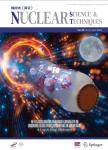Development of a high-speed digital pulse signal acquisition and processing system based on MTCA for liquid scintillator neutron detector on EAST
作者机构:Institute of Plasma PhysicsHefei Institutes of Physical ScienceChinese Academy of SciencesHefei 230031China University of Science and Technology of ChinaHefei 230026China Institute of EnergyHefei Comprehensive National Science CenterHefei 230031China
出 版 物:《Nuclear Science and Techniques》 (核技术(英文))
年 卷 期:2023年第34卷第10期
页 面:60-72页
核心收录:
学科分类:082704[工学-辐射防护及环境保护] 08[工学] 082701[工学-核能科学与工程] 0827[工学-核科学与技术]
基 金:supported by the Users with Excellence Program of the Hefei Science Center CAS (No. 2020HSC-UE012) the Comprehensive Research Facility for Fusion Technology Program of China (No. 2018-000052-73-01-001228) the Institute of Energy,Hefei Comprehensive National Science Center (Nos. 21KZS205, 21KZL401 and 22KZZ502)
主 题:EAST NES High-speed MTCA n–γdiscrimination Entire pulse waveform
摘 要:In this experimental study, involving deuterium–deuterium fusion neutron emission spectroscopy measurement on the experimental advanced superconducting tokamak(EAST), a liquid scintillator detector(BC501 A) was employed. This decision was based on the detector s superior sensitivity, optimal time-response, and its exceptional n–γ discrimination capability. This detector emits fast pulse signals that are as narrow as 100 ns, with high count rates that can peak at several Mcps. However, conventional nuclear circuits faced challenges in performing pulse height analysis, n–γ pulse shape discrimination, and in recording the entire pulse waveform under such high count rate conditions. To address these challenges, a high-speed digital pulse signal acquisition and processing system was designed. The system was developed around a micro-telecommunications computing architecture. Within this structure, a signal acquisition and processing(SAQP) module communicated through PCI Express links, achieving a bandwidth of up to 1.6 GB/s. To accurately capture the detailed shape of the pulses, four channels of analog-to-digital converters were used, each with a 500-MSPS sampling rate and a 14-bit resolution, ensuring an accuracy that surpassed 11 bits. An n–γ discrimination algorithm, based on the two-gate integral method, was also developed. Implemented within field programmable gate arrays, this algorithm provided a real-time n–γ discrimination spectrum for pulse height analysis. The system underwent rigorous testing in a laboratory setting and during an EAST experiment. The results confirmed that the innovative SAQP system can satisfy the demanding requirements of high-parameter experiments, manage count rates of up to 2 Mcps, execute real-time n–γ discrimination algorithms, and record entire pulse waveforms without any data loss.



